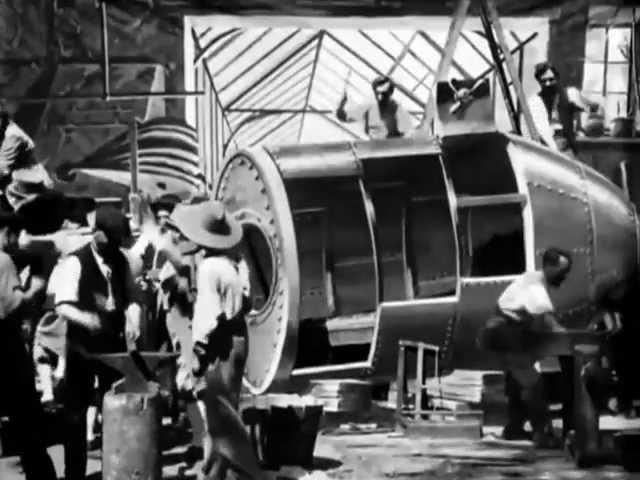
"Le Voyage dans la Lune" George Méliès 1902 (Original version, silent and black & white)
This is the original version, silent and black & white.
This film is available in the public domain.
Le Voyage dans la Lune, alternately "Voyage to the Moon", is a 1902 French black-and-white silent science fiction film. It is based loosely on two popular novels of the time: Jules Verne's "From the Earth to the Moon" and H. G. Wells "The First Men in the Moon".
The film was written and directed by Georges Méliès, assisted by his brother Gaston. The film runs 14 minutes if projected at 16 frames per second, which was the standard frame rate at the time the film was produced. It was extremely popular at the time of its release, and is the best-known of the hundreds of fantasy films made by Méliès. A Trip to the Moon is the first known science fiction film, and uses innovative animation and special effects, including the well-known image of the spaceship landing in the Moon's eye.
It was named one of the 100 greatest films of the 20th century by The Village Voice, ranking at #84.
At a meeting of astronomers, their president proposes a trip to the Moon. After addressing some dissent, six brave astronomers agree to the plan. They build a space capsule in the shape of a bullet, and a huge cannon to shoot it into space. The astronomers embark and their capsule is fired from the cannon with the help of "marines", most of whom are portrayed as a bevy of beautiful women in sailors' outfits, while the rest are men. The Man in the Moon watches the capsule as it approaches, and it hits him in the eye.
Landing safely on the Moon, the astronomers get out of the capsule and watch the Earth rise in the distance. Exhausted by their journey, the astronomers unroll their blankets and sleep. As they sleep, a comet passes, the Big Dipper appears with human faces peering out of each star, old Saturn leans out of a window in his ringed planet, and Phoebe, goddess of the Moon, appears seated in a crescent-moon swing. Phoebe calls down a snowfall that awakens the astronomers. They seek shelter in a cavern and discover giant mushrooms. One astronomer opens his umbrella; it promptly takes root and turns into a giant mushroom itself.
At this point, a Selenite (an insectoid alien inhabitant of the Moon, named after one of the Greek moon goddesses, Selene) appears, but it is killed easily by an astronomer, as the creatures explode if they are hit with a hard force. More Selenites appear and it becomes increasingly difficult for the astronomers to destroy them as they are surrounded. The Selenites arrest the astronomers and bring them to their commander at the Selenite palace. An astronomer lifts the Chief Selenite off his throne and dashes him to the ground, exploding him.
The astronomers run back to their capsule while continuing to hit the pursuing Selenites, and five get inside. The sixth uses a rope to tip the capsule over a ledge on the Moon and into space. A Selenite tries to seize the capsule at the last minute. Astronomer, capsule, and Selenite fall through space and land in an ocean on Earth. The Selenite falls off and the capsule floats back to the surface, where they are rescued by a ship and towed ashore.
The final sequence depicts a celebratory parade in honor of the travelers' return, including the unveiling of a commemorative statue.This ending sequence was considered lost until 2002, when a well preserved complete print was discovered in a barn in France. The extended version was screened at the Pordenone Silent Film Festival in 2003, and the sequence was included and restored in full for the 2012 Blu-Ray edition of the film.
Like many of Méliès's films, A Trip to the Moon was sold in both black-and-white and hand-colored versions. A hand-colored print, the only one known to survive, was rediscovered in 1993 by the Filmoteca de Catalunya. It was in a state of almost total decomposition, but a frame-by-frame restoration was launched in 1999 and completed in 2010 at the Technicolor Lab of Los Angeles- and after West Wing Digital Studios matched the original hand tinting by colorizing the damaged areas of the newly restored black and white. The restored version finally premiered on 11 May 2011, eighteen years after its discovery and 109 years after its original release, at the 2011 Cannes Film Festival.
Some historians suggest that although A Trip to the Moon was among the most technically innovative films up until that time, it still displays a primitive understanding of narrative film technique.
Méliès had intended to release the film in the United States to profit from it. Thomas Edison's film technicians, however, secretly made copies of it and distributed it throughout the country. While the film was still hugely successful, Méliès eventually went bankrupt.This was due in part to the eventual view which was held towards his films that the special effects were overshadowing the plot.
More info; http://en.wikipedia.org/wiki/A_Trip_to_the_Moon
This film is available in the public domain.
Le Voyage dans la Lune, alternately "Voyage to the Moon", is a 1902 French black-and-white silent science fiction film. It is based loosely on two popular novels of the time: Jules Verne's "From the Earth to the Moon" and H. G. Wells "The First Men in the Moon".
The film was written and directed by Georges Méliès, assisted by his brother Gaston. The film runs 14 minutes if projected at 16 frames per second, which was the standard frame rate at the time the film was produced. It was extremely popular at the time of its release, and is the best-known of the hundreds of fantasy films made by Méliès. A Trip to the Moon is the first known science fiction film, and uses innovative animation and special effects, including the well-known image of the spaceship landing in the Moon's eye.
It was named one of the 100 greatest films of the 20th century by The Village Voice, ranking at #84.
At a meeting of astronomers, their president proposes a trip to the Moon. After addressing some dissent, six brave astronomers agree to the plan. They build a space capsule in the shape of a bullet, and a huge cannon to shoot it into space. The astronomers embark and their capsule is fired from the cannon with the help of "marines", most of whom are portrayed as a bevy of beautiful women in sailors' outfits, while the rest are men. The Man in the Moon watches the capsule as it approaches, and it hits him in the eye.
Landing safely on the Moon, the astronomers get out of the capsule and watch the Earth rise in the distance. Exhausted by their journey, the astronomers unroll their blankets and sleep. As they sleep, a comet passes, the Big Dipper appears with human faces peering out of each star, old Saturn leans out of a window in his ringed planet, and Phoebe, goddess of the Moon, appears seated in a crescent-moon swing. Phoebe calls down a snowfall that awakens the astronomers. They seek shelter in a cavern and discover giant mushrooms. One astronomer opens his umbrella; it promptly takes root and turns into a giant mushroom itself.
At this point, a Selenite (an insectoid alien inhabitant of the Moon, named after one of the Greek moon goddesses, Selene) appears, but it is killed easily by an astronomer, as the creatures explode if they are hit with a hard force. More Selenites appear and it becomes increasingly difficult for the astronomers to destroy them as they are surrounded. The Selenites arrest the astronomers and bring them to their commander at the Selenite palace. An astronomer lifts the Chief Selenite off his throne and dashes him to the ground, exploding him.
The astronomers run back to their capsule while continuing to hit the pursuing Selenites, and five get inside. The sixth uses a rope to tip the capsule over a ledge on the Moon and into space. A Selenite tries to seize the capsule at the last minute. Astronomer, capsule, and Selenite fall through space and land in an ocean on Earth. The Selenite falls off and the capsule floats back to the surface, where they are rescued by a ship and towed ashore.
The final sequence depicts a celebratory parade in honor of the travelers' return, including the unveiling of a commemorative statue.This ending sequence was considered lost until 2002, when a well preserved complete print was discovered in a barn in France. The extended version was screened at the Pordenone Silent Film Festival in 2003, and the sequence was included and restored in full for the 2012 Blu-Ray edition of the film.
Like many of Méliès's films, A Trip to the Moon was sold in both black-and-white and hand-colored versions. A hand-colored print, the only one known to survive, was rediscovered in 1993 by the Filmoteca de Catalunya. It was in a state of almost total decomposition, but a frame-by-frame restoration was launched in 1999 and completed in 2010 at the Technicolor Lab of Los Angeles- and after West Wing Digital Studios matched the original hand tinting by colorizing the damaged areas of the newly restored black and white. The restored version finally premiered on 11 May 2011, eighteen years after its discovery and 109 years after its original release, at the 2011 Cannes Film Festival.
Some historians suggest that although A Trip to the Moon was among the most technically innovative films up until that time, it still displays a primitive understanding of narrative film technique.
Méliès had intended to release the film in the United States to profit from it. Thomas Edison's film technicians, however, secretly made copies of it and distributed it throughout the country. While the film was still hugely successful, Méliès eventually went bankrupt.This was due in part to the eventual view which was held towards his films that the special effects were overshadowing the plot.
More info; http://en.wikipedia.org/wiki/A_Trip_to_the_Moon
Тэги:
#Le_Voyage_dans_la_Lune #Voyage_to_the_Moon #black-and-white #silent #Original_version #science_fiction_film #George_Méliès #1902Комментарии:
What's New in Tokyo? and Mt.Fuji Travel Alert.
Tokyo Kenchan
Mac Declos - 24/7 [MCVS003]
HATE Lab
നല്ല സമയത്തിന്റെ മനശ്ശാസ്ത്രം
Gopinath Muthukad
Alexander Eder - Für diesen Moment (Lyric Video)
Alexander Eder
Join a Ski Camp in Hintertux | Stomp It Camps
Stomp It Tutorials
My Investment is in TROUBLE - HP repairable laptops
Linus Tech Tips


![Mac Declos - 24/7 [MCVS003] Mac Declos - 24/7 [MCVS003]](https://invideo.cc/img/upload/NHpOUHZuVUFLNjk.jpg)























